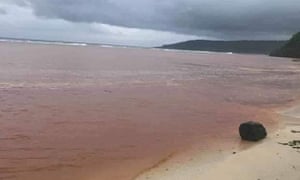
Second Spillage Turning the Water Red
A second major spill has hit the pristine Solomon Islands bay where a bulk carrier ran aground on a coral reef and leaked oil earlier this year.
On Monday, an estimated 5,000 tonnes of bauxite, the ore used in aluminium smelting, slipped into the water at Kangava Bay, Rennell Island, while it was being loaded on to a barge.
“The water is red. It’s like a scene from the Exodus,” a source on the island told the Guardian.
It is the second major environmental disaster for the area this year.
How did it happen?
MV Solomon Trader ran aground on a reef in February, spilling about 80 tonnes of heavy fuel oil. The vessel was there to load bauxite from the island’s mining operations, which lies on the doorstep of a world heritage site in the island’s east.
Clean-Up Deal Sign Off in July
The Guardian understands the Solomon Islands government is expected to sign off on the four-month oil spill clean up on 17 July, following the completion of the environmental assessment.
“The impact of the oil is not nearly as bad as you would expect. The oil isn’t likely to cause any long-term damage,” a separate person on the ground told the Guardian.
“The bauxite is the overwhelming issue by a long shot and that is causing substantial long term changes to the marine ecosystem.”
Ongoing mismanagement of bauxite loading has resulted in the whole bottom of the bay, down to several hundred metres, being covered in the mineral, the source said.
“It’s just totally out of control,” he said.
How the people are coping?
According to an Earther Gizmodo article, these contamination events spell trouble for the local reef ecosystem, which is so special that the site sits on the UNESCO World Heritage List. They’re also having an impact on the roughly 1,200 people who live on the island, including members of the Tehakatu’u tribe, as they typically collect rainwater to drink and fish from the bay for food, the article further states.
Struggling with Water:
Last time, community members struggled with drinking water and food in the wake of the disaster. People are being advised not to fish again, Derek Pongi, the Tehakatu’u Development Association chairman, told Earther via Facebook. But while Pongi says some are resorting to processed canned foods, The Guardian reports that other people aren’t heeding these warnings. Meanwhile, children continue to swim and play in the water, according to photos provided by Pongi.

Authorities providing clean water
The Tehakatu’u Development Association has been providing water to locals and has contributed almost $500 (4,000 Solomon Island Dollars) to the community since last week’s spill. They’ll need every dollar; this spill could impact the coral reefs permanently if they struggle to find sunlight beneath all the bauxite powder, per the Guardian. If corals die, it’s possible not as many fish will come to the bay anymore.
Environment Assessment To Be Over on July 17
The environmental assessment for the last spill should wrap by July 17, according to the Guardian. In wake of this latest spill, Tehakatu’u Development Association will try to commission an independent assessment, said Pongi to Earther.
So far, there’s no news on when clean up will begin or how long it’ll take for this most recent disaster—but the government needs to hurry up. People’s well-being is on the line.
Ocean To Be Adversely Effected
University of Technology Sydney water and ecology expert Martina Doblin warned the bauxite powder was likely to smother and bury what is on the ocean floor and will be spread around in tidal currents.
“It could limit the amount of light, so the water is cloudy and that means less light penetration for coral and sea grasses … it would have a harmful effect,” Doblin said.
OceansWatch Solomon Islands spokesman Lawrence Nodua said the contamination would cause problems for fish breeding.
“Normally fish come to where the coral are, so if the coral dies, they won’t be there, and [will lose the reef protection],” he said.
He claimed there were reports that children swimming in the bay were experiencing skin irritation from the poor water quality.
How shipping is hit in the area?
A Bintan Mining Solomon Islands company spokesman told the Guardian on Thursday that loading operations were suspended following the incident on Monday. The company would not comment further.
Sources on the ground said the company had moved loading operations to other parts of the island. During the height of the oil spill disaster, Bintan Mining Solomon Islands faced criticism for continuing with its bauxite loading operations.
Plight of UNESCO Heritage Site
While currents pushed slick away from the world heritage site, the Guardian has been told small amounts have washed up in the area.
“Nothing significant, literally the size of a 50c piece here or there,” another source said.
Since 2013 the site has been on a Unesco danger list because of logging and overfishing.
Compensations To Take Time
The bulk carrier’s insurer, KP&I, said negotiations over clean-up operation costs would kick off soon but warned compensation claims would take time.
Although matters of liability are yet to be determined, the insurer and ship owner have previously “expressed deep remorse” and characterized the situation as “totally unacceptable”. Comment has been sought from the Solomon Islands Maritime Authority, National Disaster Management Office and mining ministry.
Did you subscribe to our daily newsletter?
It’s Free! Click here to Subscribe!
Source: The Guardian , Earther Gizmodo


















